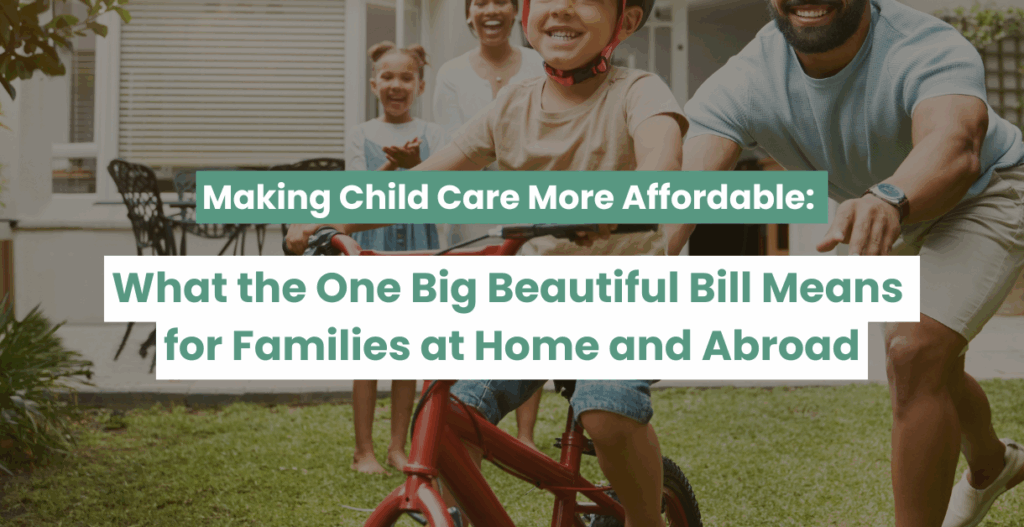

Heather Marcello
Heather joined Basswood Counsel as a Law Clerk and Administrator in 2022. She works on our tax team assisting foreign tax clients with their U.S. tax filing obligations and estate planning clients with their long-term estate planning goals.
This is a follow-up to our previously published articles, where we introduced the major provisions of the OBBBA impacting individual taxpayers.
The OBBBA introduced extensive reforms to federal tax benefits for families, and this article will focus on Child Tax Credit (CTC) and Child and Dependent Care Tax Credit (CDCTC). These changes under the OBBBA are designed to provide financial relief to working families and to address the rising costs of childcare across the United States. U.S. citizens raising families abroad will continue to benefit from these tax credits when filing their U.S. tax returns.
Changes to the Child Tax Credit (CTC) and Additional Child Tax Credit
- Increased Credit Amounts
The CTC is a tax credit that was created to provide financial relief to families raising children or caring for other dependents. The 2017 Tax Cuts and Jobs Act (TCJA) temporarily increased the CTC amount to $2,000 per qualifying child and $500 for other dependents. This temporary increase was set to expire at the end of 2025, but OBBBA permanently increased the maximum credit amount to $2,200 per qualifying child beginning in 2025. The CTC amount will be adjusted annually for inflation beginning in 2026. It also made the $500 credit per dependent permanent.
The refundable portion of the CTC, also known as the Additional Child Tax Credit, is worth up to $1,700 in 2025. OBBBA established that this refundable amount will be permanent and indexed for inflation beginning in 2026.
- Lower Phase-Out Thresholds
OBBBA made the phase out of the child tax credit for individuals with a modified adjusted gross income (AGI) of $200,000 ($400,000 for joint filers) permanent. This includes the $500 non-refundable tax credit for dependents. This phase-out rate was adjusted so that more middle-income families can benefit. Parents and guardians with higher incomes may continue to partially claim the credit incrementally.
- Change in Identification Requirement
Prior to the OBBBA, a parent or guardian could claim CTC on their tax return using a valid taxpayer identification number (ITIN, or SSN). The OBBBA requires that, beginning in 2025, a taxpayer must provide a work-eligible Social Security number for themselves, for their spouse (if filing jointly), and for each qualifying child to claim the CTC. This change will disqualify many taxpayers in the U.S. and overseas who previously qualified for the tax credit. Families, where the child is a U.S. citizen with an SSN but one or both parents have ITINs, will lose out on the financial relief the CTC was established to create.
Changes to Child and Dependent Care Tax Credit (CDCTC)
- Higher Credit Rates
The CDCTC was established to help working families offset the cost of childcare so that parents and guardians could work or look for work while unemployed. It allows parents and guardians to receive a tax credit for a percentage of their claimed childcare expenses. Prior to OBBBA, the maximum credit amount taxpayers could claim was up to 35% of their childcare expenses. Beginning in 2026, parents and guardians can receive a maximum credit of up to 50% of their claimed childcare expenses up to $3,000 for one qualifying individual or $6,000 for two or more.
- Expanded Income Eligibility and Maximum Credit Rate
In addition to increasing the maximum credit to 50% of claimed childcare expenses, OBBBA expands income eligibility for parents and guardians claiming the CDCTC. Beginning in 2026, the percentage of tax credit a taxpayer can receive incrementally decreases as incomes increase. Individuals with an AGI between $0 and $15,000 ($30,000 filing jointly) can receive a maximum credit of up to 50% of their claimed childcare expenses.
The credit percentage gradually reduces from 50% to 35% for taxpayers with an AGI between $43,001 and $75,000 ($150,000 filing jointly). From there, the percentage amount phases down to 20% for taxpayers with an AGI between $75,000 and $103,000 ($150,000 and $206,000 filing jointly). This change allows more taxpayers to qualify for some percentage of the tax credit, receiving more relief than before.
- Maximum Credit
Prior to OBBBA, the maximum credit amount was about $600 for one qualifying individual and $1,200 for two qualifying individuals. OBBBA increased these amounts to about $1,050 for one qualifying individual and $2,100 for two qualifying individuals, beginning in 2026. However, these credits are nonrefundable, meaning that any amount not applied to taxes owed will not be distributed to the taxpayer as a refund.
What This Means for Dual Citizens Living Abroad
Refundable credits like the CTC can result in actual cash back, even if you do not owe U.S. taxes due to the Foreign Earned Income Exclusion (FEIE) or Foreign Tax Credits (FTC). In addition to U.S. Citizenship, many taxpayers living abroad elect to apply for Social Security numbers for their children and dependents so they may qualify for the CTC. If you are a dual citizen and you or your spouse meet the substantial presence test, you may qualify for CDCTC for expenses incurred for international childcare if the care provider is not a relative and meets the other requirements set by the IRS. This can help offset the high cost of international childcare, which is often not subsidized.
These changes will not solve everything, but they are a meaningful step toward making childcare more affordable for working families. If you are raising children and working hard to make ends meet—whether in the U.S. or abroad—this policy shift may help lighten the load. If you have questions about these changes and how they impact you and your family while filing your annual tax returns, contact Basswood Counsel. We’ve got you covered.
Read our related articles analyzing the One Big Beautiful Bill Act and its implications for wealth and estate planning, and businesses.